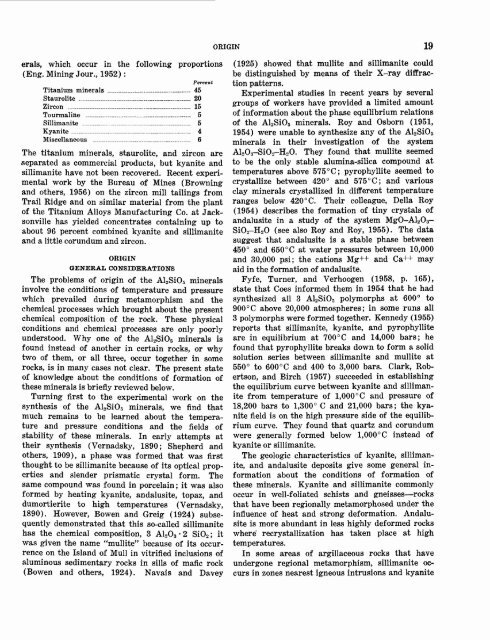Kyanite, Sillimanite, and Andalusite Deposits of the Southeastern ...
Kyanite, Sillimanite, and Andalusite Deposits of the Southeastern ...
Kyanite, Sillimanite, and Andalusite Deposits of the Southeastern ...
Create successful ePaper yourself
Turn your PDF publications into a flip-book with our unique Google optimized e-Paper software.
ORIGIN 19<br />
erals, which occur in <strong>the</strong> following proportions<br />
(Eng. Mining Jour., 1952):<br />
Percent<br />
Titanium minerals -__-_ ______-__- 45<br />
Staurolite .________________________________ ___ __ _... 20<br />
Zircon __ _____________________________________._______ _ ____ ________ 15<br />
Tourmaline ..... ... _ ._.._ 5<br />
<strong>Sillimanite</strong> - __ -____-_-_ ___________ _ 5<br />
<strong>Kyanite</strong> _ ___-__-______-^___________-_.___ _________________________ 4<br />
Miscellaneous _________________________._____.________...._.________ 6<br />
The titanium minerals, staurolite, <strong>and</strong> zircon are<br />
separated as commercial products, but kyanite <strong>and</strong><br />
sillimanite have not been recovered. Recent experimental<br />
work by <strong>the</strong> Bureau <strong>of</strong> Mines (Browning<br />
<strong>and</strong> o<strong>the</strong>rs, 1956) on <strong>the</strong> zircon mill tailings from<br />
Trail Ridge <strong>and</strong> on similar material from <strong>the</strong> plant<br />
<strong>of</strong> <strong>the</strong> Titanium Alloys Manufacturing Co. at Jacksonville<br />
has yielded concentrates containing up to<br />
about 96 percent combined kyanite <strong>and</strong> sillimanite<br />
<strong>and</strong> a little corundum <strong>and</strong> zircon.<br />
ORIGIN<br />
GENERAL CONSIDERATIONS<br />
The problems <strong>of</strong> origin <strong>of</strong> <strong>the</strong> Al2Si05 minerals<br />
involve <strong>the</strong> conditions <strong>of</strong> temperature <strong>and</strong> pressure<br />
which prevailed during metamorphism <strong>and</strong> <strong>the</strong><br />
chemical processes which brought about <strong>the</strong> present<br />
chemical composition <strong>of</strong> <strong>the</strong> rock. These physical<br />
conditions <strong>and</strong> chemical processes are only poorly<br />
understood. Why one <strong>of</strong> <strong>the</strong> Al2Si0 5 minerals is<br />
found instead <strong>of</strong> ano<strong>the</strong>r in certain rocks, or why<br />
two <strong>of</strong> <strong>the</strong>m, or all three, occur toge<strong>the</strong>r in some<br />
rocks, is in many cases not clear. The present state<br />
<strong>of</strong> knowledge about <strong>the</strong> conditions <strong>of</strong> formation <strong>of</strong><br />
<strong>the</strong>se minerals is briefly reviewed below.<br />
Turning first to <strong>the</strong> experimental work on <strong>the</strong><br />
syn<strong>the</strong>sis <strong>of</strong> <strong>the</strong> Al2Si05 minerals, we find that<br />
much remains to be learned about <strong>the</strong> temperature<br />
<strong>and</strong> pressure conditions <strong>and</strong> <strong>the</strong> fields <strong>of</strong><br />
stability <strong>of</strong> <strong>the</strong>se minerals. In early attempts at<br />
<strong>the</strong>ir syn<strong>the</strong>sis (Vernadsky, 1890; Shepherd <strong>and</strong><br />
o<strong>the</strong>rs, 1909), a phase was formed that was first<br />
thought to be sillimanite because <strong>of</strong> its optical properties<br />
<strong>and</strong> slender prismatic crystal form. The<br />
same compound was found in porcelain; it was also<br />
formed by heating kyanite, <strong>and</strong>alusite, topaz, <strong>and</strong><br />
dumortierite to high temperatures (Vernadsky,<br />
1890). However, Bowen <strong>and</strong> Greig (1924) subsequently<br />
demonstrated that this so-called sillimanite<br />
has <strong>the</strong> chemical composition, 3 A1203 2 Si02 ; it<br />
was given <strong>the</strong> name "mullite" because <strong>of</strong> its occurrence<br />
on <strong>the</strong> Isl<strong>and</strong> <strong>of</strong> Mull in vitrified inclusions <strong>of</strong><br />
aluminous sedimentary rocks in sills <strong>of</strong> mafic rock<br />
(Bowen <strong>and</strong> o<strong>the</strong>rs, 1924). Navais <strong>and</strong> Davey<br />
(1925) showed that mullite <strong>and</strong> sillimanite could<br />
be distinguished by means <strong>of</strong> <strong>the</strong>ir X-ray diffraction<br />
patterns.<br />
Experimental studies in recent years by several<br />
groups <strong>of</strong> workers have provided a limited amount<br />
<strong>of</strong> information about <strong>the</strong> phase equilibrium relations<br />
<strong>of</strong> <strong>the</strong> Al2Si05 minerals. Roy <strong>and</strong> Osborn (1951,<br />
1954) were unable to syn<strong>the</strong>size any <strong>of</strong> <strong>the</strong> Al2Si0 5<br />
minerals in <strong>the</strong>ir investigation <strong>of</strong> <strong>the</strong> system<br />
Al203-Si02-H20. They found that mullite seemed<br />
to be <strong>the</strong> only stable alumina-silica compound at<br />
temperatures above 575°C; pyrophyllite seemed to<br />
crystallize between 420° <strong>and</strong> 575°C; <strong>and</strong> various<br />
clay minerals crystallized in different temperature<br />
ranges below 420 °C. Their colleague, Delia Roy<br />
(1954) describes <strong>the</strong> formation <strong>of</strong> tiny crystals <strong>of</strong><br />
<strong>and</strong>alusite in a study <strong>of</strong> <strong>the</strong> system MgO-Al203-<br />
Si02-H20 (see also Roy <strong>and</strong> Roy, 1955). The data<br />
suggest that <strong>and</strong>alusite is a stable phase between<br />
450° <strong>and</strong> 650 °C at water pressures between 10,000<br />
<strong>and</strong> 30,000 psi; <strong>the</strong> cations Mg++ <strong>and</strong> Ca++ may<br />
aid in <strong>the</strong> formation <strong>of</strong> <strong>and</strong>alusite.<br />
Fyfe, Turner, <strong>and</strong> Verhoogen (1958, p. 165),<br />
state that Goes informed <strong>the</strong>m in 1954 that he had<br />
syn<strong>the</strong>sized all 3 Al2Si0 5 polymorphs at 600° to<br />
900°C above 20,000 atmospheres; in some runs all<br />
3 polymorphs were formed toge<strong>the</strong>r. Kennedy (1955)<br />
reports that sillimanite, kyanite, <strong>and</strong> pyrophyllite<br />
are in equilibrium at 700°C <strong>and</strong> 14,000 bars; he<br />
found that pyrophyllite breaks down to form a solid<br />
solution series between sillimanite <strong>and</strong> mullite at<br />
550° to 600 °C <strong>and</strong> 400 to 3,000 bars. Clark, Robertson,<br />
<strong>and</strong> Birch (1957) succeeded in establishing<br />
<strong>the</strong> equilibrium curve between kyanite <strong>and</strong> sillimanite<br />
from temperature <strong>of</strong> 1,000 °C <strong>and</strong> pressure <strong>of</strong><br />
18,200 bars to 1,300° C <strong>and</strong> 21,000 bars; <strong>the</strong> kyanite<br />
field is on <strong>the</strong> high pressure side <strong>of</strong> <strong>the</strong> equilibrium<br />
curve. They found that quartz <strong>and</strong> corundum<br />
were generally formed below 1,000 °C instead <strong>of</strong><br />
kyanite or sillimanite.<br />
The geologic characteristics <strong>of</strong> kyanite, sillimanite,<br />
<strong>and</strong> <strong>and</strong>alusite deposits give some general information<br />
about <strong>the</strong> conditions <strong>of</strong> formation <strong>of</strong><br />
<strong>the</strong>se minerals. <strong>Kyanite</strong> <strong>and</strong> sillimanite commonly<br />
occur in well-foliated schists <strong>and</strong> gneisses rocks<br />
that have been regionally metamorphosed under <strong>the</strong><br />
influence <strong>of</strong> heat <strong>and</strong> strong deformation. <strong>Andalusite</strong><br />
is more abundant in less highly deformed rocks<br />
where recrystallization has taken place at high<br />
temperatures.<br />
In some areas <strong>of</strong> argillaceous rocks that have<br />
undergone regional metamorphism, sillimanite occurs<br />
in zones nearest igneous intrusions <strong>and</strong> kyanite
















